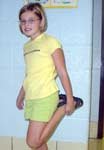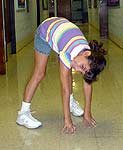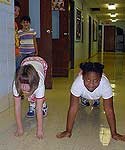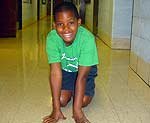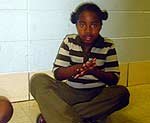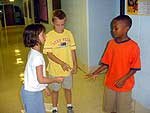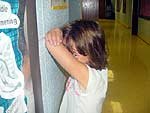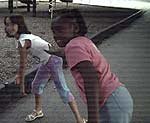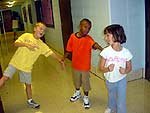Enough has been said about childhood obesity and children developing diabetes II faster than the adult population. The media drones on about it with false outrage between ads for Oreo cookies and Snickers bars almost daily. It is time to do something.
Get Kids Moving!
Here is a three-pronged program to get elementary school children moving:
- Stretching for elementary school children
- Non-competitive games that can be played inside and outside
- Field Day activities

Stretching
Stretching is important at any age but especially children since their muscles and bones have not finished growing yet. Though injuries to children are more easily repaired than for adults, bone and ligament injuries never repair as fully as healthy new muscle. Stretching is generally overlooked in children's training programs yet children need to stretch for the same reasons as adults.
Older children may follow similar stretching exercises such as suggested by Brian Jones on page 582 in Dolfzine Magazine; younger children require a bit more fantasy and adventure. You cannot tell a first grader that stretching increases circulation and expect results.
Hence the following animal poses designed to teach flexibility, strength, balance, concentration, and the importance of stretching, presented as play, achieve the desired results. When directing students in the movement, the instructor or leader should be gently instructing them to:
- Breathe evenly,
- Not hold their breath,
- Move in and out of each stretch slowly and
- Not make any quick movements that might strain a muscle or bone.
Though the most important thing is for the children to have fun, they develop workout techniques that will carry them through their adult lives. The following animal poses are suggested activities for young children. The leader, instructor or teacher must be prepared to demonstrate. Making animal noises, finger plays, songs and jokes adds to the fun and play but be assured these are real and demanding exercises.
Elephant Walk
Direction:
Put your fingers together then bend over slowly from a standing position. With your back straight, swing your arms back and forth like an elephant's trunk as you walk.
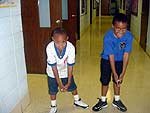
the elephant walk stretches out the shoulders, arms and strengthen your legs.
Flamingo Stand
Direction:
Stand with your feet together and place your palms together in front of your chest with your fingers pointed up. Focus on a spot in front of you and bend forward from the waist. Bend one leg up and hold as long as you can. Straighten up to stand with your feet together. Now let us do the other leg.
The flamingo stand presents new difficulties. If a child is uncoordinated have, him/her stands and holds on to a chair or brings their leg just slightly off the floor. This exercise also strengthens and stretches out your legs and ankles and focuses on balance.
Inch Worm
Direction:
Assume a position where your feet are on the floor (shoulder width) while your hands are flat on the ground in front of you (also shoulder width). At the starting position, your butt should be high in the air; imagine you are making an inverted "V" with your body. Walk your hands out as far as possible, and then walk your hands back to the starting position. Preferably, at the end position, your abs should be two to three inches off the ground and you will look like a flying superman.
The inchworm stretches and strengthens the back, shoulder, hamstrings, and gluteus maxim us. It also strengthens the gluteus medius and the rest of the arm.
Bear Crawl
Direction:
On All Fours, you move along the floor keeping yourself low. Chest remains off the floor, as you should move at a moderate pace to avoid "hopping".
The bear crawl can be done moving forward, backward, or sideways. The bear crawl stretches and strengthens the hamstrings, gastroneimus, sole us, the gluteus maxim us, and back. It also teaches coordination, agility, and speed.
Seal Pose
Direction:
Sit back almost on your heels -- not completely back on heels where it would hurt your knees and ankles. Point your fingers to the side like flippers. With back flat, lift your chest to straighten elbows. Keep your seat off your heels and hold the pose.
The seal pose will take some explanation, direction, and correction to get right. The seal pose stretches and strengthens the quadriceps, abductors, adductors, the sartious, patella, and back. It also teaches balance, coordination, and agility.
If you are working with a large group, it would be advisable to have assistants and go over the poses with the beforehand. Some of the children will do these naturally; some will have difficulty.

Cooperative Games
Remember how it felt to be the last one picked for gym. In the following games, this does not happen. The games website by Dale Lefevre is an excellent resource for books and videos to assist you in presenting games. These games have been tested in over 500 game seminars and done around the world.
The CD's, videos, seminars and equipment available through this website will prove invaluable to whoever is going to lead games. The obvious must be stressed. Unless the leader is fully in control of the nature of the game, the children are bound to confused. The leader must do his/her homework prior to introducing a game to the children.
These games divided into three different sections:
- low activity
- moderate activity
- high activity
Low Activity Games
The low activity games are ideal to be played indoors on a rainy or snowy day.
Rain Game
The rain game is an excellent choice for teachers to keep the children occupied on a rainy day as well as introduce sections from the weather curriculum. It is extremely exciting to do at an assembly with a large group. You can set the mood by playing nature music that deals with a thunderstorm or classical music that sounds like rain.
Rain Game - (5 - 50 players, low activity).
Direction:
Start in a circle, passing sounds to create a rainstorm. Each player keeps making the sound until the next one comes around. Sounds include finger-tapping, chest thumping, foot stamping, thigh slapping, clapping, rump thumping, finger napping, tongue clucking, and rubbing and shushing.
Make a comment to end the game, such as something about attracting sun or rain, whichever is needed.
The purpose of this game is to calm children down, help them develop fine motor skills, and teach them the ability to focus. The rain game also emphasizes such elements as working in groups, listening to directions, and depending on one another for the game to be successful. It is good to do when the children are restless and need to relax before ending a game session or before moving on to a higher level of activity.
Make 11
I use this game when I need time filler.
Make 11 - (3 to 50+ players in groups of three, low activity).
Groups form in a circle. Groups face each other and at the count of three, put out one hand with a number of fingers extended, trying to reach a total of 11. The purpose of this game is to get students to work together to figure out how to "make 11." The students work at this until they understand the game, then they repeat the game using both hands, trying to total 21 or any other number determined by the teacher.
This game teaches coordination, verbal communication, visual acuity, muscle reaction, and helps students develop their fine motor skills. It also teaches the concepts of trust, team building, problem solving, and self-control.
Captain Video
Have you ever played the game telephone. This is similar.
The name of this game is derived from the students' need to use their "special powers" of paying attention to small visual details, such as Superman looking through a wall or Wonder Woman dodging bullets using only her small metal wristbands.
(Number of players: 5 to 10)
- This game is played in a circle, and after the teacher demonstrates how the game works, players face out from the center.
- To start, one player (at first, the person demonstrating the game) stands in the middle and taps another player on the back (everyone will be facing outward at this point). The second player turns around to face the middle to watch the first player, who then makes a simple movement or two before taking the place of the second player in the circle, but now facing in toward the middle.
- The second players does not repeat the movement immediately, but goes to a third player in the circle, taps them on the shoulder, and repeats the movements, remembering them to the best of his or her ability. This goes on from player to player until the last player turns around and is shown the movement(s).
- The last player and the first meet in the middle stand back to back, and at the count of three do the movement so players can then see how much the movement has changed. To finish the game, have the first and last players face each other and at the count of three do the movement again. No special equipment is needed for this game and it teaches visual acuity, memory, and motor skills development. It also teaches the concepts of adaptability, self-control, creativity, spontaneity, and following directions.
Moderately Active Games
These are great to do inside or outside in limited amount of space.
(When I taught at a private school, the children wanted to play this game every day. It was great because the children ran the game themselves and I was able sit at my desk and prepare for the next activity.)
Four Corners - (Number of players is 5-35.)
There are four corners that players can go to, each of which will be clearly identified with a number from one to four. One player starts in the middle, closes his or her eyes, and slowly counts to 10 aloud while the other players quietly go to one of the corners. At this point, the person in the middle will call out the number of a corner.
Everyone who is in that corner joins the middle person. One of them will be chosen as the new caller. Everyone can help count. The process is repeated until either one person or no one is left. At that point, the game can start again. The last person that gets called out is the next caller or he/she can choose someone to be the caller for the next game.
This game teaches students how to stop quickly and safely, how to keep quiet and it also contributes to the development of fine motor skills and a sense of direction. The secondary skills include creativity and problem solving.
Cranes and Crows
Cranes and Crows (5 - 35 players in two straight lines facing each Other)
To play this game, set up boundaries wide enough for a rectangle to accommodate all players with a middle line (it can be invisible between two markers). Divide the group into two lines, with the players in each line standing side by side and facing each other over the middle line, two arms' width apart.
Each group of players has a safety line about 20 feet behind it, parallel to the middle line. One line of players is the "cranes" and the other is the "crows." The games leader or instructor stands at one end of the lines and shouts the names of the lines, "crows," "cranes," or any word beginning with a "c," or "cr," such as "chrome," "cranium," "cone," "cat," etc. The reason for using other words that sound like but are not "crows" or "cranes" is to teach the players to listen carefully.
Only when a team's name is called does it chase the other line and to tag them before they run back to reach their safety line, which is located about 30 feet in back of them, depending on the age and ability level of the group. Any one who is caught joins the other team, changing from a crane to a crow or vice versa. The teams then reform their lines in the middle and repeat the process. It is important to make sure the players are aware of others that are around them so they do not bump into each other.
This game can be played with or without equipment. It may be helpful to use chalk, cones, or ropes to serve as the "safety line" that the students touch when they are safely "home." This game teaches running, visual ability, tactile contact, and reaction. It also teaches the concepts of self-control, adaptability, and speed.
This activity is fun when you play along. Teens love to fool the adult when they are in charge.
Active games can be played inside and out but make sure you move the furniture and have a wide-open space with no obstacles.
Blob
(5 to 50+ players, active)
This game derives its name from the science-fiction movie called "The Blob," in which a massive alien organism attempts to take over the earth by devouring and absorbing everything in its path, thus allowing it to grow as it advances. This game also teaches us that monsters are not always scary and we may have more "animal" in us than we think.
Directions:
It is best to play this game in a large area with boundaries. One student will start out as "The Blob," and when he or she tags someone, that person joins hands with him or her and they try to catch others together. When there are at least four, they can split into two blobs. This repeats until everyone is caught.
The students learn such developmental skills as verbal contact, tactile contact, endurance, balance, visual acuity, visual ability, reaction, and running. This game also teaches students the concepts of adaptability to change, problem solving, spontaneity, speed, pantomime, self-control, and cooperation. Furthermore, the game provides children with a great cardiovascular workout.
Oh Deer
Oh, Deer (10 to 50 players)
Directions:
Divide group in two, a group of resources, and a group of deer. Both line up facing each other, and then turn away from each other. Resources line chooses to be either shelter (hands over head forming a roof,) water (hands on mouth or do the sign for drink or water), food (hands on stomach). Deer chooses what they need in the same manner. At a given signal, both groups turn to face each other, then deer run over to the resource that matches the one they have chosen. If a deer does not find what needs are, it becomes a resource.
To add excitement, add a third element, mountain lions, who try to eat the deer on their way to get resources; lions could face away from middle to begin also.
Oh, Deer develops physical agility as well as mental alertness. It teaches about survival while also developing such skills as tactile contact, adaptability, self-control, pantomime, visual ability, reaction, speed, and running.
Hula Hoop Tag
Materials: Hula Hoop for every other player; Arm Band for the tagger to wear
Directions:
Have every other person be it (tagger) or the "tag-ee." If there is, an uneven number of children allow for two tag gees and one tagger. Have the taggers chase the tag gees into the hula-hoop. The tag gees can be in a free space by putting their whole bodies in the hula-hoop. Taggers can move the hula-hoops but Tag gees cannot take the hula-hoop with them.
Players change roles when one is tagged. Make sure the tagger wears the armband to show that he or she is the tagger. Taggers can change whom they want to tag. The tagger becomes the tag gee and so on. Make sure you have an open space and remind students to watch out for each other so that they are not hit.
Persons in wheel chairs can use a piece of carpet to go on instead of a hula-hoop.
Other adaptations. One person can be it and the other children are tagged by the tagger. When the one person is tagged, she/he becomes it or the tagger.
These ideas are merely suggestions. As you continue to work with children, you will decide which games and stretches are ideal for your specific group. If you are new to working with children, you will quickly learn that directions must be very specific. When teaching children to march, if you do not direct them to step with their right foot after they step with the left, many will just keep stepping with the left foot and drag the right along. Young children are truly an adventure.
A field day can be a great way to encourage healthy habits. These ideas are taken from PE Central's Kentucky's Core Content a great website to give you ideas on encouraging healthy habits.
Dental Health Relay
Brush Your teeth Mini Lesson - Here is a riddle. You talk with them. You eat with them. They are small, sharp, and white. Can you guess what they are? They are your teeth. Caring for your teeth helps you stay healthy and look your best. If you take care of your teeth, they will last your whole life. You use your teeth to chew your food. Chewing is one of their main functions. Leftover pieces of food on your teeth can cause bacteria on your teeth or plaque. The bacteria in plaque can cause cavities. Brushing after each meal will help prevent cavities. To remove plaque between your teeth, you need to floss.
Event Directions - Students will form six equal lines. On the GO, signal the first student to run down to the supply box, get a toothbrush, and lay it on the picture of the teeth. Then he/she will tag the next student. Then, that student will go to the box and get the toothpaste. The event continues as followed. (Toothbrush, toothpaste, cup, water, towel, mouth rinse, and dental floss.) The team that gets all the supplies first wins the event!
Healthy Bone Relay
Your Fragile Body Mini Lesson - Your body is very fragile. You must take safety precautions to protect your body from injury. Can you think of a safety precaution you can use to prevent injuries? How can you prevent your body from being injured on a bike? Or a skateboard? What about in a car? Wearing a safety belt in a car will help to keep you from being forced against the inside of the car or from being throwing from the car in the event of a car crash.
Event Directions:
The students will be divided into 6 teams. One-half of the team will form a line opposite ends of the field. Each team will be given an egg, a large spoon, and a rubber band. On go, the first person on each team will take the rubber band and wrap it around the egg. Then they will walk their egg to the other end of the field and hand off to their teammate. The relay continues until all the students have taken their egg on a ride. If a team breaks their egg, they will continue the race without an egg
Food Pyramid Relay
This game is a good review if you have been working with the food pyramid.
A Balanced Meal Mini-Lesson - A Food Guide Pyramid is a tool that can help you have a healthful diet. The Food Guide Pyramid divides foods into groups. It tells you how many servings you should eat from each food group each day. It can help you to choose a healthy balance of foods. It reminds you not to eat too many unhealthy foods. By using the Food Pyramid, you can be sure to get a balanced diet.
Event Directions:
Students will form six equal lines. On GO the first student and their buddy in each line will walk with their lunch tray to the center circle of plastic foods. They will choose a food from the Food Guide Pyramid. After choosing their food and placing it on the tray, they hand the tray to the second student and buddy.
The event continues in this way until the team has a food from each group on the Food Guide Pyramid. If a student drops a food, that food must be returned to the circle. The first team to complete the balance sits down. Then they will explain the foods and what group they are from and how they have built a balanced meal.

Conclusion
Teaching children about fitness in a fun and creative way will help them develop habits of daily exercise for a lifetime. No matter if you are a personal trainer, teacher or parent children are eager to please and will adapt good habits that you value for a lifetime if you just encourage them to.
References:
- Le Fevre, Dale, Best New Games. Human Kinetics. Illinois. 2002.
- Luby, Thia, Pose Like the Animals. Highlights Magazine, September 2003.
Dolfzine Magazine.com PE Central.com
Thanks,
Chris Chapman

